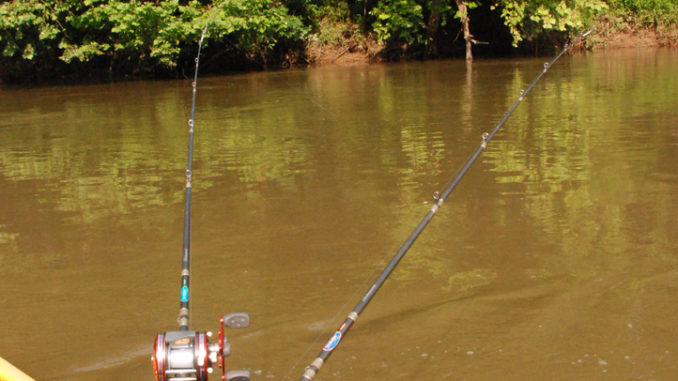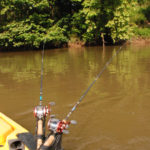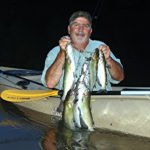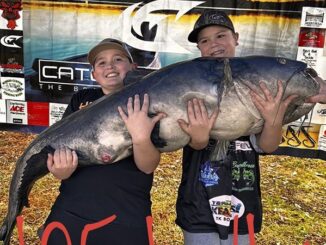
Fishing for a fish fry requires distinct rigging
Setting up your kayak to target catfish may seem like the simplest thing in the world. Although anglers have caught catfish by casting, the vast majority of catfish are caught basically the same way: using multiple rods baited with some type of cut, live or manufactured baits.
The complexity of catfishing from a kayak comes in deciding whether you want to target big trophy species like blue and flathead catfish, or if you want to be the most popular guy in your neighborhood, the one who regularly invites friends over for a southern fried delicacy. If so, you’ll be targeting eating-size blues and channel catfish.
June is an ideal time to load up on channel cats. Water temperatures are rising rapidly, and spring is rolling over into summer. This transition means airborne insects in trees often find their way into the water, while waterborne insects are emerging and finding their way to the surface. At the same time, invertebrates and crustaceans — crawfish and clams — are also abundant in shallow water along with the fry of recently spawned fish. That’s going to limit your kayak fishing areas to depths of less than 10 to 15 feet.
If you used your kayak for crappie fishing in the early spring, it’s time to find your rod-holders and put them back on the kayak. Most kayaks have built-in gear tracks, but if your boat doesn’t, you can buy track, which come in a multitude of colors so as not to upset your boat’s color schemes.
Rod-holder bases will slide into the gear tracks and secure down, and the rod-holders fit into the base. Popular brands to look for, if you don’t already have them are Yak Attack, Scotty, RAM, and Driftmaster.
Due to limited space, about four to six rod-holders will be enough to keep you busy, plus, you’ll have to design a way to store those rods when you’re paddling to your spot. Vertical rod storage mounted to a bag or box in the rear tankwell works pretty well, while some yaks have rod tubes built into each gunwale.
Keeping fish to eat presents a small challenge to kayakers, because few have any built in livewells. Your high-dollar, super-insulated coolers will work well, though some may balk at putting a slimy catfish in their status-symbol cooler. Igloo to the rescue. Make sure whichever you choose comes with a couple of bags of ice.
Stringers may or may not be an option if fishing really skinny water. Fish die slowly and then soak in warm water until you get back to the ramp, not the best scenario for fresh-tasting fish.
Fishing for channel cats is run-and-gun bait fishing. Because of the abundance of food, you’re likely to find three to five willing fish in each spot before it’s time to move to the next. In a pond, lake or reservoir, long clay or sandy points are your best bets for channel cats in June. Paddle your boat up on the top of the point, turn it around and drag the stern up on the bank, sit back down and fan-cast rods around the point. It doesn’t take a channel cat long to find a bait, so move every 30 minutes or when the action stops.
Rivers are also great places to target channel cats and small blue cats. According to Mike Gault of Union County, it doesn’t matter which direction you cast in many South Carolina rivers this time of year; your chances are excellent of bringing back a feisty channel catfish when you reel it back in.
“I’ll get out on the Broad River about midday, find a spot, and set up camp. Two or three hours on the water is great for building an appetite and collecting dinner. Then clean ’em and fry ’em up right there on the river. It reminds me of days gone by.”
Gault suggests anglers looking to load up on channel catfish use light-action spinning gear with 8- to 10-pound test line. His bait of choice is a commercially made dip bait like Sonny’s Super Sticky Channel Catfish Bait fished on a piece of styrofoam or small sponge on a No. 2 treble hook. Any location that sells the bait should have commercially made dip-bait rigs to go with them. Gault uses a Carolina rig with a 1-ounce egg weight ahead of the bait and casts into eddies along the bank or deeper holes in the middle.
“A piece of fresh cut bait like a bream caught right out of the river will be better for a bigger channel or blue catfish,” he said. “But if you’re looking for 50 bites an evening and a mess of catfish for dinner, the dip bait is the way to go.”
Boat positioning in moving water means you’ll need an anchor trolly to hoist the anchor line to the rear of the kayak to hold the boat straight. You can use a small grapple anchor or, if fishing a river that has timber sticking up or over-hanging the water, you can attach a spring loaded clamp or brush clip to the end of your anchor line, trolling the line to the back of the boat and let the current settle you in to your spot.
Just watch out for snakes.







Be the first to comment